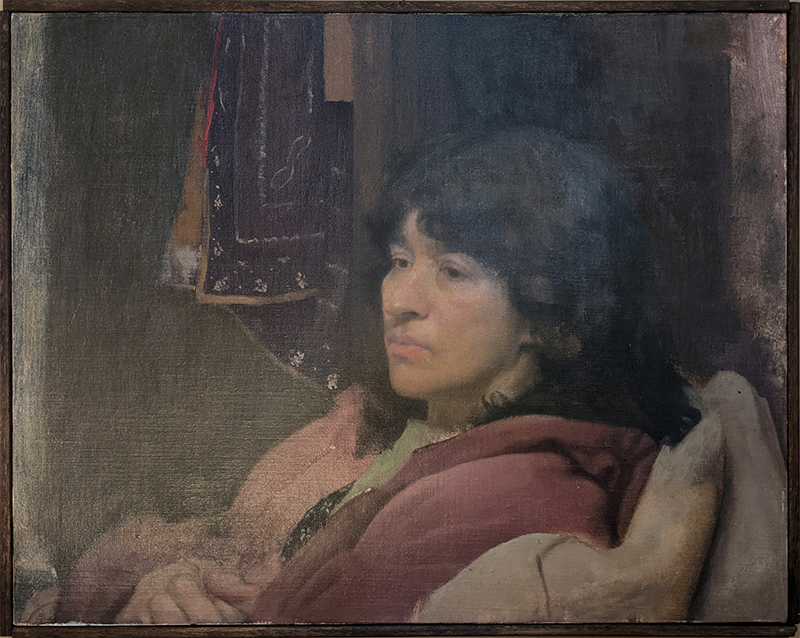Review | Lennart Anderson Portraits at the Lyme Academy of Fine Arts
Lennart Anderson, Portrait of Barbara S. (the first one), 1972; Oil on Canvas, 21 7/8 x 18 in. Collection of Vincent Arcilesi.
Review | Lennart Anderson Portraits at the Lyme Academy of Fine Arts
Douglas R. Giebel
Late last year, a retrospective of paintings by Lennart Anderson opened at the New York Studio School in lower Manhattan and was welcomed by a series of positive reviews. The artist spent most of his career in New York City, painting in his Park Slope studio while teaching briefly at Pratt Institute and then at Brooklyn College. A series of three retrospectives, the first since Anderson’s death in 2015, has been organized by the artist’s daughter, Jeanette Anderson Wallace. The second iteration of this series opened in January at the Lyme Academy of Fine Arts, curated by two of their faculty members, Amaya Gurpide and Jordan Sokol. Their selection of more than thirty works includes both some figurative drawings and a greater range of portraits than the Manhattan exhibition.
This reflects the Lyme Academy’s traditional figurative pedagogy, which Anderson shared, going back to Edwin Dickinson, Charles Hawthorne, and even back to Velázquez. The hanging of the exhibit in the Academy’s Chauncey Stillman Gallery features the portrait by stringing eight of them together along one wall, allowing an instructive comparison. Six of these portraits are painted with bare canvas left surrounding the head. These "floating heads" as the artist called them, grew out of his discovery, early in his career, of a Jacques Louis David portrait of Filippo Mazzei, a study for The Oath of the Tennis Court.
David’s painting isolates the head with raking light giving it a strong volumetric form while the remaining white canvas envelopes the head. As the selections in the Lyme exhibit demonstrate, Anderson made extensive use of this summary form throughout his career but found it particularly helpful in later years as it enabled him to concentrate on the quick, unified resolution of the form of the head.
The strongest of these ‘floating heads’ to my eye is that of David Gordon, painted in 1994, more than forty years after he first painted Gordon when they were MFA students together at the Cranbrook Academy of Art in Bloomfield Hills, Michigan, just outside Anderson’s native city of Detroit. When they were graduate students, Anderson visited Gordon’s father’s home in New York City and studied the catalogs which he owned of the Degas’ estate sale. This deepened his interest in this artist whose portraits and figurative, narrative pieces would inspire Anderson throughout his career.
The Gordon portrait shows the strength of the ‘floating head’ form. The head is delicately rendered with closely pitched and highly refined flesh tones that articulate the soft features, gentle eyebrows, and tender eyes which regard the viewer with a heart-warming human empathy. He is set at a slight three-quarter view revealing a strongly-painted, dimensional left ear. A grey v-neck sweater is suggested, scumbled over and scraped down to create an unnamable neutral tone that evaporates out to the blank canvas, enveloping the solid head in a breathable, airy space.
These isolated, ‘floating heads’ also draw upon the Roman Faiyum portrait form, which Anderson admired and acknowledged to be an influence on his portraits. Faiyum portraits were painted using encaustic (melted wax) on panels placed at the head of wooden caskets, satisfying the ancient Egyptian religious need of providing a surrogate body for the soul of the deceased. The quickly-executed brushwork of the encaustic technique gives the eyes and lips a vivacious sparkle that creates a life-like appearance to the face, enhancing its function as the preserver of the soul of the deceased. The spontaneous, quick execution of Anderson’s ‘floating heads’ also enhances their life-like vitality.
Seeing these portraits together in a sequence on one wall enables one to notice subtle differences, such as the positioning of the head in relationship to the whole canvas. A 1995 portrait of his daughter Jeanette at age six, for example, has her head positioned low on the canvas. By contrast, the head of his retiring chairman at Brooklyn College, Morris Dorsky, is large, more fully filling the frame, wearing a self-assured, somewhat disdainful look.
Lennart Anderson, Portrait of a Young Black Man, 1993; Oil on Canvas, 22 x 17 in. Collection of Richard T. Spurzem.
In another, Portrait of a Young Black Man, the head appears smaller, and more distant, bespeaking the circumstance in which the painting was done, in class at Brooklyn College with less opportunity for the intimacy and close scrutiny possible with friends and family members posing in his own studio.
The most intimate of these portraits are those done of his wife Barbara, seen in two paintings included in the Lyme exhibit. The earlier, acknowledged as such in its title, Portrait of Barbara S. (the first one), was painted in 1972. Unlike the ‘floating heads,’ this portrait surrounds the sitter’s head with dark tones allowing the lively flesh tones of the head and shoulders to shine more resonantly. A light gray drapery behind a portion of the head contrasts with the dark hair immediately in front of it, forming a more volumetric solid. The sitter’s gaze seems unsettled as it is directed at the artist in a three-quarter view. Another, much larger full-figure portrait of Barbara was done four years later and is now in the collection of the Pennsylvania Academy of Fine Arts in Philadelphia.
Lennart Anderson, Portrait of Barbara Stenglein-Anderson, 1990-1991; Oil on Canvas; 16 x 20 in., Private Collection.
This painting, unable to be loaned for the retrospective, clearly shows the artist’s identification with the sitter, soon to be his wife. She is situated in his studio, with accouterments associated with the artist’s interests; Piero Della Francesca and Mantegna reproductions on the wall, and a neoclassical statue which frequently appears in the artist’s still lives.
A second Portrait of Barbara Stenglein in the Lyme exhibit contrasts noticeably with the earlier two described above. Anderson indicated it was “painted mornings when Jeanette was two or three years old [in 1990-1991] and still asleep.” He positions the half-figure of his wife close to the picture plane, sitting obliquely, tightly swathed in a warm coat, with a dark tone behind the head giving her hair a soft volume. The red-violet coat creates a velvety texture through its tones, and attention to detail in the head and hands continues in the delicate pattern on the drapery and black cloth above her folded hands. The posture and placement of the figure in this horizontal composition give an aura of domestic comfort and contentment, in contrast to the anxious, vertically placed figure in the first portrait done eighteen years earlier. The overall deep tonality of the later portrait echoes that of the still lives painted at the same time, giving this portrait an affirming sense of assured resolve.
As the quattrocento Florentine painters began to recover the ancient Roman capacity for a realistic portrait, the Italian humanist architect Leon Baptista Alberti recognized the humanizing power of this skill. In his treatise On Painting, Alberti observed: “Painting contains a divine force which not only makes absent men present, as friendship is said to do, [Cicero, De amicitia, vii, 23] but moreover makes the dead seem almost alive. Even after many centuries, they are recognized with great pleasure and with great admiration for the painter” (On Painting, Book 2).
Anderson’s current exhibition at the Lyme Academy helps us understand the significance of the portrait. To paint an individual is to affirm their human significance, and Anderson’s portraits wonderfully demonstrate that. This trio of retrospectives also confirms the continuing importance of his work as it reveals the contemporary benefit of preserving this valuable tradition.
Lennart Anderson: A Retrospective continues at the Lyme Academy of Fine Arts through March 18, 2022.
Douglas R. Giebel is an artist, art historian, and a former student of Lennart Anderson.






